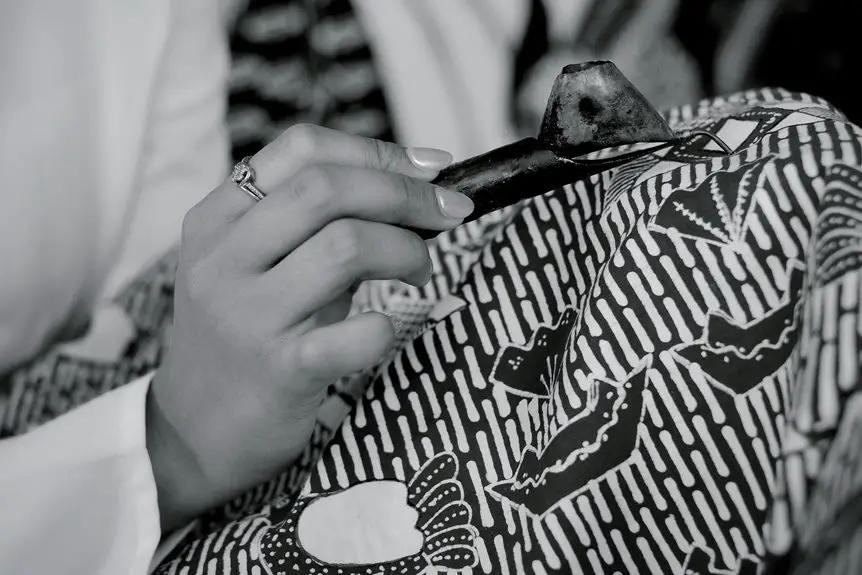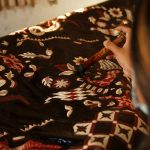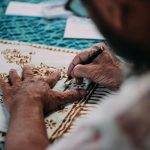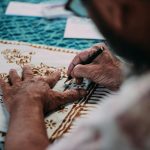To make batik fabric, start with a plain, natural cloth like cotton. You’ll apply hot wax in your chosen pattern using a canting tool or brush. Once the wax hardens, dip the fabric into a dye bath to color the exposed areas. Repeat waxing and dyeing for multiple colors. Finally, remove the wax by boiling or scraping to reveal your design. If you want to master each step and create stunning batik pieces, there’s plenty more to discover.
Table of Contents
Key Takeaways
- Start with a plain natural fabric like cotton or silk, washed and ironed for smoothness.
- Sketch your desired pattern lightly on the fabric as a guide for wax application.
- Melt beeswax or paraffin and apply it using a canting, brush, or stamp to create resist areas.
- Dye the fabric in baths, allowing wax-covered parts to resist color, repeating waxing and dyeing for layered designs.
- Remove the wax by boiling or scraping, revealing the intricate batik pattern underneath.
Understanding the Basics of Batik
Batik is a traditional fabric dyeing technique that uses wax to create intricate patterns. When you apply wax to cloth, it resists the dye, leaving the covered areas undyed.
Batik uses wax on fabric to resist dye, creating beautiful, detailed patterns with undyed areas.
This method allows you to craft detailed, multi-layered designs by repeating waxing and dyeing steps. You’ll work on natural fabrics like cotton or silk since they absorb dye effectively.
The wax acts as a barrier, so when you immerse the fabric in dye, only the unwaxed parts change color. After dyeing, you remove the wax by boiling or scraping, revealing your design.
Understanding this wax-dye interaction is essential before you start. Mastering these basics lets you control the pattern’s complexity and color layering, ensuring your batik fabric turns out vibrant and unique.
Gathering the Necessary Materials
Now that you understand how wax and dye interact to create patterns, you’ll need to gather the right materials to bring your design to life.
Start with a plain, natural fabric like cotton or silk, as synthetic fibers don’t absorb dye well. You’ll need a container for melted wax—beeswax or paraffin works fine.
To apply the wax, get a tjanting tool or a brush, depending on your design’s detail. Prepare several dye baths in different colors to layer your patterns effectively.
Have gloves and aprons on hand to protect your skin and clothes. Also, keep newspapers or plastic sheets nearby to prevent messes.
Finally, a heat source for melting wax and a workspace with good ventilation will make the process smoother and safer.
Preparing the Fabric for Dyeing
Before you start applying wax or dye, you’ll want to prepare your fabric to guarantee it absorbs colors evenly and the patterns come out crisp. Begin by washing the fabric to remove any sizing, oils, or dirt that might resist the dye. After washing, iron the fabric to make it smooth and crease-free. Finally, stretch the fabric on a frame or flat surface to keep it taut during waxing and dyeing.
| Step | Action | Tip |
|---|---|---|
| 1 | Wash fabric | Use mild detergent |
| 2 | Rinse thoroughly | Avoid fabric softeners |
| 3 | Dry fabric | Air dry for best results |
| 4 | Iron fabric | Use steam for stubborn creases |
| 5 | Stretch fabric | Secure tightly on frame |
Designing Your Batik Pattern
Once your fabric is prepped and stretched, you can focus on creating the design that will bring your piece to life. Start by choosing a theme or motif that resonates with you, whether geometric, floral, or abstract.
Begin your batik journey by selecting a meaningful motif that inspires your creative expression.
Next, sketch your pattern lightly on the fabric using a pencil or fabric marker to guide your wax application later. Finally, consider the scale and repetition of your design to maintain balance and harmony across the fabric.
Here’s a quick guide to designing your batik pattern:
- Select a clear, inspiring motif that fits your style.
- Draft your design with light, precise lines for accuracy.
- Plan the layout, deciding where elements repeat or stand alone.
This preparation guarantees your batik fabric will showcase a striking and well-thought-out design.
Applying Wax to the Fabric
Now that you have your design, it’s time to apply the wax carefully to the fabric.
You’ll want to choose the right type of wax—usually a mix of beeswax and paraffin—to get the best results.
Using tools like a canting or brush, you can create precise lines and shapes that will resist the dye later on.
Wax Application Techniques
Applying wax to your fabric is an essential step that defines the intricate patterns and resist areas in batik making.
To apply wax effectively, you’ll want to master these techniques:
- Drawing with a Canting: Use this small, spouted tool to draw fine lines and details with hot wax. It gives you precise control for delicate designs.
- Stamping with a Cap: Dip a copper stamp into molten wax and press it onto the fabric to create repetitive patterns quickly and uniformly.
- Brush Application: For larger areas or softer edges, use a brush to paint melted wax onto the fabric. This technique allows for varied textures and shading effects.
Types of Wax Used
Three main types of wax are commonly used in batik fabric making, each offering unique properties that affect your design and process.
You’ll find paraffin wax, beeswax, and a blend of both. Paraffin wax is easy to melt and apply, making it ideal for beginners. It’s also less expensive but can crack if the fabric is stretched too much.
Beeswax, on the other hand, is more flexible and provides a stronger resist, which helps when you want sharper, more detailed patterns. However, it’s harder to remove during dyeing.
The blend combines the ease of paraffin with the durability of beeswax, giving you a balanced option. Choosing the right wax depends on your design complexity and how you plan to handle the fabric afterward.
Dyeing the Fabric With Color
Before you begin dyeing, make sure your wax designs have fully cooled and hardened; this will prevent the colors from bleeding.
Next, prepare your dye bath according to the fabric type and desired color intensity. When you’re ready, gently immerse the fabric into the dye, ensuring even coverage.
Follow these steps for effective dyeing:
- Stir the fabric occasionally to avoid uneven patches.
- Check the color frequently; remember, it appears darker when wet.
- Remove the fabric once you’ve achieved the desired shade.
After dyeing, rinse the fabric in cold water to remove excess dye without disturbing the waxed areas.
This process adds vibrant color while preserving your intricate batik patterns, setting the stage for the final finishing touches.
Removing Wax and Finishing Touches
Once the dye has set and your fabric is dry, you’ll need to remove the wax to reveal your batik design. To do this, gently boil the fabric in hot water or iron it between sheets of absorbent paper to melt and soak up the wax. This step is essential for clarity and vibrancy.
Here’s a quick guide to removing wax and finishing touches:
| Step | Tip |
|---|---|
| Boil in hot water | Use a large pot, stir gently |
| Iron with paper | Use brown paper or newspaper |
| Repeat if needed | Wax may require multiple cycles |
After wax removal, rinse and dry your fabric thoroughly to complete the process. Your batik is now ready to use or display!
Caring for Your Batik Fabric
After removing the wax and finishing your batik fabric, you’ll want to keep it looking vibrant and beautiful for years to come. Proper care preserves the colors and texture, ensuring your handiwork stays stunning.
Here’s how to care for your batik fabric:
- Wash Gently: Use cold water and mild detergent. Avoid harsh chemicals or bleach, as they can fade the colors. Hand washing is best to maintain delicate patterns.
- Dry Carefully: Air dry your fabric in shade to prevent sun damage and color fading. Avoid wringing out the fabric to keep the fibers intact.
- Store Properly: Fold your batik fabric loosely and keep it in a cool, dry place. Avoid plastic bags that trap moisture and cause mildew.
Frequently Asked Questions
What Is the History of Batik Fabric?
You’ll find batik fabric’s history dates back centuries, originating in Indonesia. It’s a wax-resist dyeing technique that spread across Asia and Africa, influencing cultures and art, making it a treasured traditional craft worldwide.
Which Countries Are Famous for Batik Production?
You’ll find Indonesia, Malaysia, and Nigeria famous for batik production. Indonesia, especially Java, leads with rich designs. Malaysia and Nigeria also craft unique batik styles, reflecting their cultures and traditions beautifully.
Can Batik Techniques Be Used on Synthetic Fabrics?
Like trying to write poetry on plastic, batik techniques struggle on synthetic fabrics. You won’t get the same wax absorption or dye effect, so natural fibers work best to capture batik’s true artistic spirit and vibrant colors.
How Does Batik Compare to Other Fabric Dyeing Methods?
You’ll find batik stands out because it uses wax to resist dye, creating intricate patterns. Unlike tie-dye or dip-dye, you get more detailed, sharp designs with batik’s wax-resist method that others can’t easily replicate.
Are There Environmental Concerns With Traditional Batik Dyeing?
You should know traditional batik dyeing can cause environmental concerns, like water pollution from synthetic dyes and wax waste. You can reduce impact by using natural dyes and proper waste management to keep the process eco-friendly.
- Tetron Fabric for Marine Applications: Durability and Use Cases - June 18, 2025
- Tetron Fabric for Outdoor Furniture: Weather Resistance and Care - June 18, 2025
- Tetron Fabric for Wall Coverings: Style and Application Tips - June 18, 2025






